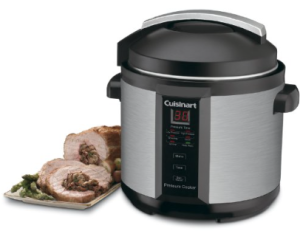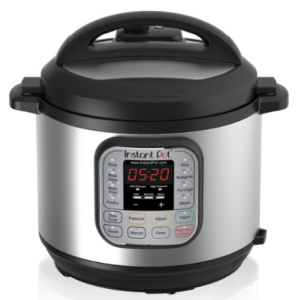A pressure cooker is one of the most versatile pieces of kitchen equipment a chef can own. A pressure cooker requires less water than a traditional stove and the cooker can reach an optimal temperature in a short amount of time. Food can be prepared quickly and easily using a pressure cooker making a popular kitchen appliance.
There are 2 main types of pressure cookers: stovetop and electric. Both types have their own benefits and drawbacks and it comes down to user preference. Stovetop models work quickly and are usually built from heavy-duty materials. When not being used as a pressure cooker, stovetop models can double as a stockpot. Electric models are a popular choice because they can also be used as slow cookers or steamers. Electric pressure cookers automatically regulate pressure, so there’s no guesswork, and there’s a reduced risk of an accident. Electric pressure cookers usually come with a host of pressure settings, so you can dial in the right amount of heat and steam depending on the type of meal.
Pressure Cooker Materials
One of the most important aspects of a pressure cooker is what the pot is made from. Many modern pressure cookers are constructed from a combination of aluminum and stainless steel, but there are many models that are simply made from stainless steel or aluminum.
Aluminum Pressure Cookers
Many of the pressure cookers currently on the market are made from aluminum and offer a host of added benefits. Aluminum pressure cookers are very easy to clean and can be purchased at a competitive price. Not many other types of pressure cookers can be purchased at a price comparable to an aluminum cooker. Aluminum is a great heat conductor, which increases the overall efficiency of the device.
On the flip side, aluminum is very lightweight, so it doesn’t last as long as other metals like stainless steel. After extended use, the exterior can become warped and blemished, and the interior might stain.
Stainless Steel Pressure Cookers
Made from heavy-duty materials, pressure cookers made of stainless steel are the industry standard. Priced slightly higher than aluminum, stainless steel offers added strength and durability, which more than makes up for the increased price point. Pressure cookers made from stainless steel are often much heavier than other models, which many users consider to be a plus. One of the only issues with stainless steel is that it doesn’t conduct heat very efficiently, so it takes longer for the pressure cooker to heat up and distribute the heat.
Stainless Steep Pressure Cooker With an Aluminum Base
The best compromise between the 2 designs, a pressure cooker with a stainless steel body and an aluminum base combines the best qualities of both materials. The cookers are strong and durable due to the stainless steel body and they offer excellent heat conduction because of the aluminum base. Multi-material pressure cookers tend to be sold at a higher price point than regular cookers, but the increased quality means that the device will last longer and work efficiently.
Pressure Regulation Systems
 One of the most critical parts of a pressure cooker’s design is the device’s pressure regulation system. If the user is unable to accurately determine the amount pressure being used to cook the ingredients, they won’t be able to follow the recipe and the food may come out overcooked. Most recipes that require a pressure cooker usually specify a pressure of fifteen pounds per square inch. With a modern pressure regulation system, the user can easily determine and adjust the amount of pressure in the device. Many pressure regulators will also display when the food is being cooked and sound an alarm when the food is finished cooking. There are 3 types of regulators built into pressure cookers: weighted valve, modified weight, and spring valve pressure regulators.
One of the most critical parts of a pressure cooker’s design is the device’s pressure regulation system. If the user is unable to accurately determine the amount pressure being used to cook the ingredients, they won’t be able to follow the recipe and the food may come out overcooked. Most recipes that require a pressure cooker usually specify a pressure of fifteen pounds per square inch. With a modern pressure regulation system, the user can easily determine and adjust the amount of pressure in the device. Many pressure regulators will also display when the food is being cooked and sound an alarm when the food is finished cooking. There are 3 types of regulators built into pressure cookers: weighted valve, modified weight, and spring valve pressure regulators.
Weight Valve Pressure Regulators
One of the most common pressure regulators found in water cookers, weight valve pressure regulators rely on a few simple principles to relay and adjust the pressure. Sometimes referred to as jiggle-top pressure regulators, the device can be found on top of the cooker’s vent pipe where it rocks back and forth as excess steam is released from the vent pipe. Many users prefer weight valve pressure regulators, because you can check if the cooker is pressurized simply by looking to see if the regulator is rocking.
Modified Weighted Valve Pressure Regulators
Attached to the pressure cooker, the regulator releases excess steam in short bursts and does not rock back and forth like the weight valve pressure regulator does. Instead, the valve simply releases a short burst of steam when cooking starts and then builds pressure until it reaches the desired PSI. It’s important to keep a close eye on modified weighted pressure cookers, because they will overheat and shoot out large puffs of steam if the pressure gets too high.
Spring Valve Pressure Regulators
A modern take on a classic regulator, the spring valve pressure regulator has a simple and straightforward design. When the cooker has reached an indicated pressure level a one-inch valve pops up, which indicates that the optimal pressure has been reached. Many users prefer spring valve pressure regulators because they can be monitored visually, so the cook can continue preparing other parts of the recipe while the pressure cooker works in the background.
Additional Features
While the majority of pressure cookers have a somewhat straightforward design, it’s important to keep every aspect of the device in mind. Pressure cookers (wiki) come with many built-in features that vary depending on make and model, so it’s good to know what sort of pressure cooker you’re looking for.
Capacity
There are three standard capacities for a basic consumer pressure cooker: 4 quarts, 6 quarts, and 8 quarts (conversion site here). Many people prefer six-quart pressure cookers because they are large enough to handle most meals and can easily double as a stockpot. Large eight-quart models are recommended for anyone who plans on cooking in large batches regularly. An eight-quart pressure cooker is capable of making enough food to feed six or more people, so it’s also a good option for anyone who’s cooking for a family get-together or a special event.
Handles
When filled with food, a pressure cooker can be very heavy and the contents can be very hot, so it’s important to have a sturdy hold on the cooker. Large, sturdy handles are important on any type of pot, but they are especially important with a pressure cooker. Some top-of-the-line models include specially designed ergonomic handles that keep the user’s hands far away from the unit while offering control over the heavy pot.
External Pressure Release Valve
Even though pressure is automatically regulated and released by the cooker’s built-in pressure system, many people prefer models of water cooker with external release valves. Some recipes actually call for the pressure to be released immediately after a certain amount of time, so a quick-release mechanism is very important for cooking as well as safety.
Cooking Basket and Racks
Many pressure cookers come standard with internal cooking racks, which allows for greater control over the heat that’s applied to the food. Food can be put in a basket to keep it way from liquids, or used to keep certain ingredients separate from one another.
Some Things to Consider
Pressure Cooker Safety
After purchasing your pressure cooker, make sure that the lid fist properly and fastens securely. The bottom should lay completely flat and the handles should be firmly attached to the sides of the cooker.
Pressurized steam can be dangerous, so it’s important that the pressure cooker has a cover interlock mechanism. Some high-end models won’t start building pressure until the covers are secured and locked into place. Some models have an additional feature where the covers won’t unlock until the pressure has dropped to a safe level.
Pressure Cooker Cleaning
Many pressure cookers are dishwasher friendly (what is that?) and come with non-stick interiors, which can dramatically cut down on the amount of time and effort required to keep the cooker clean. Cooking baskets and racks usually fit in a dishwasher, so nearly every part of the pressure cooker can easily be removed and washed. An added bonus of using a pressure cooker is that you’ll have to clean fewer pots and pans. Any mess stays in the cooker, leaving your kitchen spotless.
Cooking Healthy Foods
Pressure cookers use less water than other methods of cooking, so the foods retain more of their natural vitamins and minerals. Also, the airtight seal on the cooker helps to prevent nutrients in the food from oxidizing. Pressure cookers are an excellent choice for anyone who wants to maintain a balanced diet without breaking the bank. Additionally, the cooker’s sealed environment prevented loss of flavor and moisture due to evaporation. For more tips about how to use a pressure cooker, click here. When cooked in a pressure cooker, food keeps its natural flavors and cooked meats become more juicy and tender than the would in a conventional oven. Another added bonus of using a pressure cooker is that the cooker kills most harmful microorganisms like bacteria and viruses with its heat and pressure.



